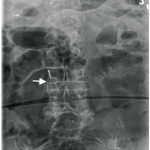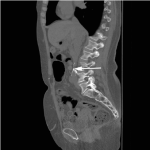| Author | Affiliation |
|---|---|
| Richard M. Pescatore, DO | Cooper University Hospital, Department of Emergency Medicine, Camden, New Jersey |
| Brigitte M. Baumann, MD, MSCE | Cooper University Hospital, Department of Emergency Medicine, Camden, New Jersey |
| David Nocchi, MD | Cooper University Hospital, Department of Emergency Medicine, Camden, New Jersey |
INTRODUCTION
A 58-year-old female presented to the emergency department complaining of low back pain following a motor vehicle crash. She denied loss of consciousness, headache, or extremity weakness. Her past medical history was notable for inferior vena cava (IVC) filter placement many years ago due to multiple pregnancy-associated deep venous thromboses (DVTs). Physical exam was unrevealing: no spinal point tenderness and a nonfocal neurologic exam. Posteroanterior lumbosacral radiograph demonstrated fracture and displacement of the posterolateral IVC filter leg (Figure 1). Computed tomography showed the filter leg to be perforated through the IVC (Figure 2). After consultation with the interventional radiologist, it was decided that the risks of retrieval outweighed potential benefits, and the patient was discharged for outpatient monitoring of the fractured limb.
Figure 1. Posterior to anterior view of lumbosacral spine. Arrowhead demonstrates fracture and displacement of the posterolateral inferior vena cava filter leg.
Figure 2. Sagittal computed tomography view of lumbosacral spine. Arrowhead demonstrates fracture and displacement of the posterolateral inferior vena cava filter leg.
DISCUSSION
From 2000–2009, the number of IVC filters placed in the United States increased from 56,380 to 132,049, with the majority in patients with a pulmonary embolism or DVT. Paralleling this increase, a rise in complications is also anticipated, including IVC filter migration, embolization and strut fracture.1 The incidence of IVC filter strut fracture ranges from 2% to a predicted 40% at 5.5 years.2,3 Strut fracture may predispose an IVC filter or a portion thereof to embolize and may also alter flow mechanics, decreasing the IVC filter’s ability to prevent a pulmonary embolism.1 In 2010, the U.S. Food and Drug Administration issued warnings regarding the safety of IVC filters after life-threatening complications occurred from filter fracture and embolization of filter limbs, including ventricular wall laceration resulting in cardiac tamponade and tachycardia induced by cardiac irritation.4,5 Given these risks, failure to identify and refer patients with IVC filter fracture for further evaluation and potential retrieval may represent a potential liability for emergency physicians in the event of embolization and subsequent injury.6
Footnotes
Supervising Section Editor: Sean O. Henderson, MD
Full text available through open access at http://escholarship.org/uc/uciem_westjem
Address for Correspondence: Richard M. Pescatore, DO, Cooper University Hospital, Department of Emergency Medicine, 1 Cooper Plaza, Kelemen 152, Camden, NJ 08103. Email: pescatore-richard@cooperhealth.edu. 3 / 2015; 16:240 – 241
Submission history: Revision received January 1, 2015; Accepted January 13, 2015
Conflicts of Interest: By the WestJEM article submission agreement, all authors are required to disclose all affiliations, funding sources and financial or management relationships that could be perceived as potential sources of bias. The authors disclosed none.
REFERENCES
1. Kuy S, Dua A, Lee CJ, et al. National trends in utilization of inferior vena cava filters in the United States, 2000–2009. Journal Vasc Surg: Venous and Lymphatic Disorders. 2014;2(1):15-20.
2. Ferris EJ, McCowan TC, Carver DK, et al. Percutaneous inferior vena caval filters: follow-up of seven designs in 320 patients. Radiology. 1993;188:851-856.
3. Tam MD, Spain J, Lieber M, et al. Fracture and distant migration of the Bard Recovery Filter: a retrospective review of 363 implantations for potentially life-threatening complications. J Vasc Interv Radiol. 2012;23:199-205.
4. Saeed I, Garcia M, McNicholas K, et al. Right ventricular migration of a recovery IVC filter’s fractured wire with subsequent pericardial tamponade. Cardiovasc Intervent Radiol. 2006;29:685-686.
5. Hull JE, Han J, Giessel GM. Retrieval of the recovery filter after arm perforation, fracture, and migration to the right ventricle. J Vasc Interv Radiol. 2008;19:1107-1111.
6. Dinglasan LV, Trerotola SO, Shlansky-Goldberg RD, et al. Removal of fractured inferior vena cava filters: feasibility and outcomes. J Vasc Interv Radiol. 2012;23:181-187.




